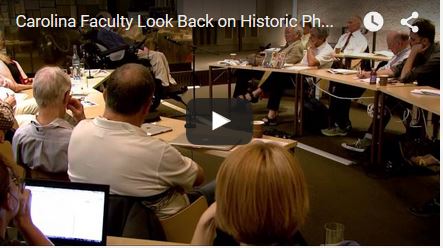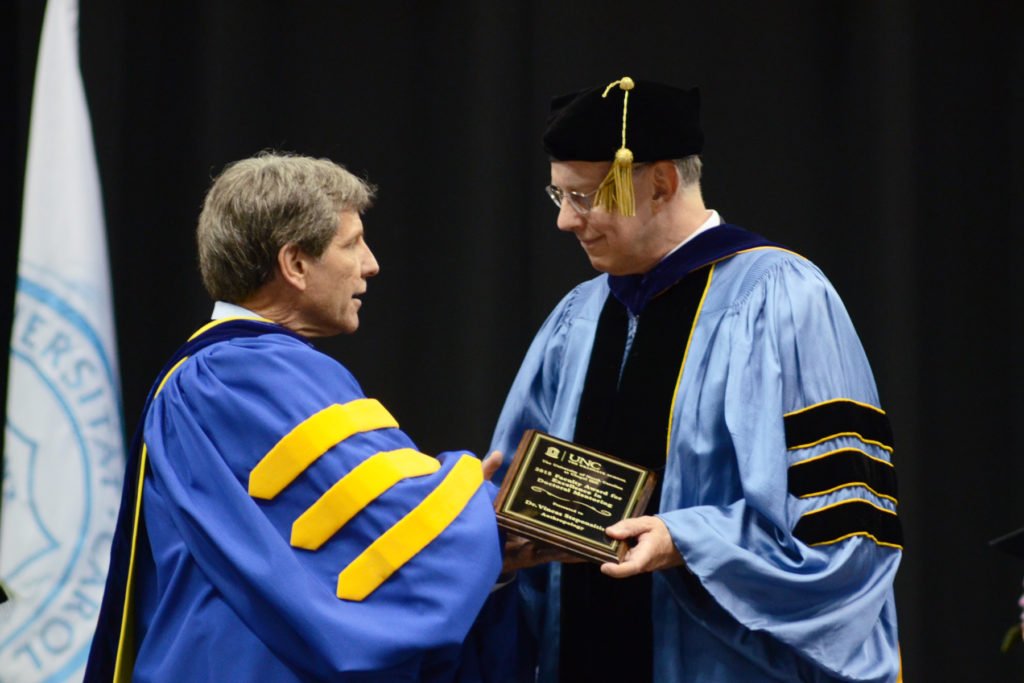The road from fish tank to wave tank started with a stick of dynamite.
In constructing Chapman Hall, contractors miscalculated either the density of the bedrock or the strength of the blasting material and ended up with a foundation hole deeper than they expected. No one recalls who made the decision to retain the underground space rather than backfill it in, but when then-marine sciences department chair Cisco Werner saw the space during a tour of the construction site in 2005, he gave a heads-up to applied mathematicians Rich McLaughlin and Roberto Camassa, the Kenan Distinguished Professor of mathematics. They requested the space for their fluids lab. At the time, the lab consisted of a collection of fish tanks in a room in Phillips Hall the size of a supply closet.
“It was dirt, no actual floor, but it spanned one whole side of the building,” Camassa said of the serendipitous cavern. “It gave us a clear shot to fit this long tank that I’d been dreaming about.”
The fluids lab has brought in more than $3.3 million in grant funding so far. In 2006, Camassa with McLaughlin, Werner and marine scientist Alberto Scotti received a highly competitive National Science Foundation grant of $744,000 to build the three-chamber tank, which was completed in 2010. Marine scientist Brian White joined the team in 2008.
The group has collaborated to win additional grants, fund research projects and train undergraduates, grad students and postdocs who work on the experiments. They were awarded a $400,000 Defense University grant from the Navy to add a saltwater filtration system to the tank so its water could be reused. Even the computer science department got involved recently when the director of the applied engineering lab, Leandra Vicci, donned a wet suit to tinker with a balky computer-controlled gate in the deep tank.
The tank’s total length is 120 feet. It can hold up to 13,500 gallons of water.
“We started doing fluid dynamics 10 years ago in a fish tank,” Camassa said. The new wave tank tests whether their theories hold true after being scaled up.
The promise of the tank attracted White to UNC from the Woods Hole Oceanographic Institution. With its ability to allow researchers to study traditional surface waves as well as density-stratified fluids and internal waves, the tank is unique among research institutions. That ability garnered a $100,000 NSF grant following the Deepwater Horizon oil spill, to study the physics of oil plumes interacting with the sort of density stratification found in the Gulf of Mexico. The mathematicians worked on why the plumes settled at the level they did; marine sciences added a new insight.
“Until we brought in marine sciences, we didn’t know that the plumes were being eaten by bacteria,” McLaughlin said. “Neither department would have been able on its own to convert research into something as relevant to real-world problems.”
With help from marine scientist Carol Arnosti, another NSF grant of $900,000 funds the lab’s study of “marine snow” — organic particles from decaying marine life in the lighter water near the ocean’s surface raining down through the heavier water near the ocean floor.
“That’s an important process in determining how much carbon gets sequestered in the deep ocean,” White said. The ocean absorbs a tremendous amount of carbon dioxide, preventing it from remaining in the atmosphere where it acts as a greenhouse gas. “Not all of this carbon, however, sinks to the deep ocean. Some of it gets released by biological processes in the upper ocean, from which it can return to the atmosphere.”
In all, about 30 undergrads, graduate students and postdocs work in the lab, supported by a five-year, $1.2 million training grant from NSF, the second such grant the lab has won.
“That will fund 10 years of training in the lab,” McLaughlin said.
Editor’s note: This story by Nancy E. Oates is part of a package of stories on “Creative Collaborations” in the College of Arts and Sciences featured in the spring ’11 Carolina Arts and Sciences magazine.
Read more “Creative Collaborations” stories: Breathing Relief, Languages Across the Curriculum, Mentoring Chemistry, UNC-Duke N.C. Poverty Project, Globe-Trotting for Tardigrades, Real-Life Ethics, Electro-Acoustic Music, Tangled Up in Blues and Making Waves.
Related Links
- See the wave tank in motion




